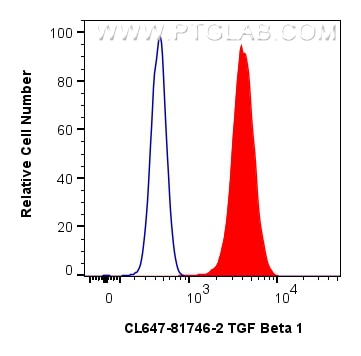Validation Data Gallery
Tested Applications
| Positive FC (Intra) detected in | HEK-293 cells |
Recommended dilution
| Application | Dilution |
|---|---|
| Flow Cytometry (FC) (INTRA) | FC (INTRA) : 0.4 ug per 10^6 cells in a 100 µl suspension |
| It is recommended that this reagent should be titrated in each testing system to obtain optimal results. | |
| Sample-dependent, Check data in validation data gallery. | |
Product Information
CL647-81746-2 targets TGF Beta 1 in FC (Intra) applications and shows reactivity with human, mouse samples.
| Tested Reactivity | human, mouse |
| Host / Isotype | Rabbit / IgG |
| Class | Recombinant |
| Type | Antibody |
| Immunogen |
CatNo: Ag13591 Product name: Recombinant human TGFB1 protein Source: e coli.-derived, PET28a Tag: 6*His Domain: 13-253 aa of BC000125 Sequence: LPLLWLLVLTPGRPAAGLSTCKTIDMELVKRKRIEAIRGQILSKLRLASPPSQGEVPPGPLPEAVLALYNSTRDRVAGESAEPEPEPEADYYAKEVTRVLMVETHNEIYDKFKQSTHSIYMFFNTSELREAVPEPVLLSRAELRLLRLKLKVEQHVELYQKYSNNSWRYLSNRLLAPSDSPEWLSFDVTGVVRQWLSRGGEIEGFRLSAHCSCDSRDNTLQVDINGFTTGRRGDLATIHGM 相同性解析による交差性が予測される生物種 |
| Full Name | transforming growth factor, beta 1 |
| Calculated molecular weight | 44 kDa |
| Observed molecular weight | 44 kDa |
| GenBank accession number | BC000125 |
| Gene Symbol | TGFB1 |
| Gene ID (NCBI) | 7040 |
| Conjugate | CoraLite® Plus 647 Fluorescent Dye |
| Excitation/Emission maxima wavelengths | 654 nm / 674 nm |
| Form | |
| Form | Liquid |
| Purification Method | Protein A purification |
| UNIPROT ID | P01137 |
| Storage Buffer | PBS with 50% glycerol, 0.05% Proclin300, 0.5% BSA{{ptg:BufferTemp}}7.3 |
| Storage Conditions | Store at -20°C. Avoid exposure to light. Stable for one year after shipment. Aliquoting is unnecessary for -20oC storage. |
Background Information
TGF Beta 1 (TGF-β1) is a pleiotropic cytokine and a member of the TGF-β superfamily (including TGF-β1, TGF-β2, and TGF-β3). It is encoded by the TGFB1 gene and acts as a secreted protein involved in controlling cell growth, proliferation, differentiation, and apoptosis. TGF-β1 is produced by various cell types (e.g., platelets, lymphocytes, macrophages, epithelial cells, and inflammatory cells) and is secreted as a precursor requiring proteolytic activation to yield the mature, biologically active peptide. TGF-β1 plays crucial roles in immune regulation, wound healing, fibrosis, and tissue remodeling (including cardiac injury and fibrosis). It also influences cancer progression by promoting epithelial-to-mesenchymal transition (EMT) and metastasis in tumors.
Protocols
| Product Specific Protocols | |
|---|---|
| FC protocol for CL Plus 647 TGF Beta 1 antibody CL647-81746-2 | Download protocol |
| Standard Protocols | |
|---|---|
| Click here to view our Standard Protocols |

